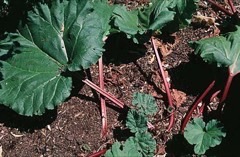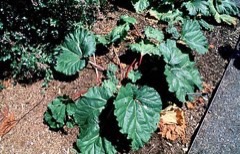 |
|
NC State University ncsu.edu |
 |
| NC State University ncsu.edu |
Translate this page:
Summary
Physical Characteristics

 Rheum x cultorum is a PERENNIAL growing to 1.5 m (5ft).
Rheum x cultorum is a PERENNIAL growing to 1.5 m (5ft).
See above for USDA hardiness. It is hardy to UK zone 3. It is in leaf from February to October, in flower in June, and the seeds ripen from July to August. The species is hermaphrodite (has both male and female organs) and is pollinated by Wind.
Suitable for: medium (loamy) and heavy (clay) soils, prefers well-drained soil and can grow in heavy clay soil. Suitable pH: mildly acid, neutral and basic (mildly alkaline) soils. It can grow in semi-shade (light woodland) or no shade. It prefers moist soil.
UK Hardiness Map
US Hardiness Map
Synonyms
R. undulatum. L.
Plant Habitats
Cultivated Beds;
Edible Uses
Edible Parts: Flowers Stem
Edible Uses: Colouring Rutin
Leaf stem - raw or cooked[1, 2, 46, 105, 200]. An acid taste, it is used as a fruit substitute in spring, usually stewed with sugar and used in pies, jams etc[183]. The juice strained from stewed rhubarb can add colour and flavour to a fruit punch[183]. It is best not to eat large quantities of the stems because of their oxalic acid content - see the notes above on toxicity. Immature flowers - cooked and used like cauliflower[183]. One report says that the plant contains 0.7% rutin[240]. It does not specify which part of the plant, though it is likely to be the leaves[K].
References More on Edible Uses
Medicinal Uses
Plants For A Future can not take any responsibility for any adverse effects from the use of plants. Always seek advice from a professional before using a plant medicinally.
Anticholesterolemic Antiseptic Antispasmodic Antitumor Aperient Astringent Cholagogue Demulcent
Diuretic Homeopathy Laxative Purgative Stomachic Tonic
The roots of many members of this genus are used medicinally. Whilst R. palmatum is the main species used in China, we have a report that this species (which has probably been derived from it through cultivation) is used in Korea[279]. The uses of R. palmatum are as follows:- Chinese rhubarb, called Da Huang in China, has a long and proven history of herbal usage, its main effect being a positive and balancing effect upon the whole digestive system. It is one of the most widely used herbs in Chinese medicine[238]. It has a safe and gentle action, safe even for children to use[254]. The plant is also part of a North American formula called essiac which is a popular treatment for cancer. Its effectiveness has never been reliably proven or disproven since controlled studies have not been carried out. The other herbs included in the formula are Arctium lappa, Ulmus rubra and Rumex acetosella[254]. The root is anticholesterolemic, antiseptic, antispasmodic, antitumor, aperient, astringent, cholagogue, demulcent, diuretic, laxative, purgative, stomachic and tonic[4, 7, 9, 21, 91, 171, 176, 238]. The roots contain anthraquinones, which have a purgative effect, and also tannins and bitters, which have an opposite astringent effect[244]. When taken in small doses, it acts as an astringent tonic to the digestive system, whilst larger doses act as a mild laxative[232, 244]. The root is taken internally in the treatment of chronic constipation, diarrhoea, liver and gall bladder complaints, haemorrhoids, menstrual problems and skin eruptions due to an accumulation of toxins[238]. This remedy is not prescribed for pregnant or lactating women, nor for patients with intestinal obstruction[238]. Externally, the root is used in the treatment of burns[238]. The roots are harvested in October from plants that are at least six years old, they are then dried for later use[4]. A homeopathic remedy is prepared from the dried root[232]. This is used especially in the treatment of diarrhoea in teething children[232].
References More on Medicinal Uses
The Bookshop: Edible Plant Books
Our Latest books on Perennial Plants For Food Forests and Permaculture Gardens in paperback or digital formats.

Edible Tropical Plants
Food Forest Plants for Hotter Conditions: 250+ Plants For Tropical Food Forests & Permaculture Gardens.
More

Edible Temperate Plants
Plants for Your Food Forest: 500 Plants for Temperate Food Forests & Permaculture Gardens.
More

More Books
PFAF have eight books available in paperback and digital formats. Browse the shop for more information.
Shop Now
Other Uses
References More on Other Uses
Cultivation details
A very easily grown plant, tolerant of considerable neglect, it prefers a deep, fertile, moderately heavy, humus rich, moisture retentive, well-drained soil in sun or semi-shade[200, 264]. It succeeds in most soils provided the drainage is good[200] and will grow in the dappled shade of trees so long as there is sufficient side light[K]. It grows well in heavy clay soils. Tolerates acid conditions but prefers a pH in the range 6.5 to 7[200]. Plants are very cold hardy, tolerating temperatures down to at least -20°c[200]. The plant does not like hot summers, however, and is likely to die in warmer climates[264]. Rhubarb is a long-lived and almost indestructible perennial plant[264]. It is often cultivated for its edible leaf stems, there are many named varieties[74, 183]. Most cultivars produce edible stems from spring to early summer, though 'Glaskin's Perpetual' can be harvested throughout the summer. By digging up the roots in the autumn and exposing them to frost, earlier growth will be initiated. These roots can then be transferred to a cold frame or other protected area where they will produce their edible stems in late winter. It is also possible to produce earlier crops outdoors by covering the plants with a layer of straw and an upturned bucket. This species is probably of hybrid origin, R. rhaponticum x R. palmatum[200]. It hybridizes freely with other members of the genus[200]. Plants in this genus seem to be immune to the predations of rabbits[233]. For polyculture design as well as the above-ground architecture (form - tree, shrub etc. and size shown above) information on the habit and root pattern is also useful and given here if available. The plant growth habit is a clumper with limited spread [1-2]. The root pattern is fibrous dividing into a large number of fine roots [1-2].
References Carbon Farming Information and Carbon Sequestration Information
Temperature Converter
Type a value in the Celsius field to convert the value to Fahrenheit:
Fahrenheit:
The PFAF Bookshop
Plants For A Future have a number of books available in paperback and digital form. Book titles include Edible Plants, Edible Perennials, Edible Trees,Edible Shrubs, Woodland Gardening, and Temperate Food Forest Plants. Our new book is Food Forest Plants For Hotter Conditions (Tropical and Sub-Tropical).
Shop Now
Plant Propagation
Seed - best sown in autumn in a shaded cold frame[200]. The seed can also be sown in spring in a cold frame. When large enough to handle, prick the seedlings out into individual pots and grow them on in the greenhouse or cold frame for their first winter, planting them out in the spring. This species is a hybrid and will not necessarily breed true to type from seed. However, this does give the opportunity to look for superior plants from amongst the seedlings. Division in early spring or autumn[1, 111]. Divide up the rootstock with a sharp spade or knife, making sure that there is at least one growth bud on each division. Larger divisions can be planted out direct into their permanent positions. We have found that it is better to pot up the smaller divisions and grow them on in light shade in a cold frame until they are well established before planting them out in late spring or early summer.
Other Names
If available other names are mentioned here
Native Range
Weed Potential
Right plant wrong place. We are currently updating this section.
Please note that a plant may be invasive in one area but may not in your area so it's worth checking.
Conservation Status
IUCN Red List of Threatened Plants Status :

Growth: S = slow M = medium F = fast. Soil: L = light (sandy) M = medium H = heavy (clay). pH: A = acid N = neutral B = basic (alkaline). Shade: F = full shade S = semi-shade N = no shade. Moisture: D = dry M = Moist We = wet Wa = water.
Now available:
Food Forest Plants for Mediterranean Conditions
350+ Perennial Plants For Mediterranean and Drier Food Forests and Permaculture Gardens.
[Paperback and eBook]
This is the third in Plants For A Future's series of plant guides for food forests tailored to
specific climate zones. Following volumes on temperate and tropical ecosystems, this book focuses
on species suited to Mediterranean conditions—regions with hot, dry summers and cool, wet winters,
often facing the added challenge of climate change.
Read More
Expert comment
Author
Thorsrud.&Reis.
Botanical References
74200
Links / References
For a list of references used on this page please go here
Readers comment